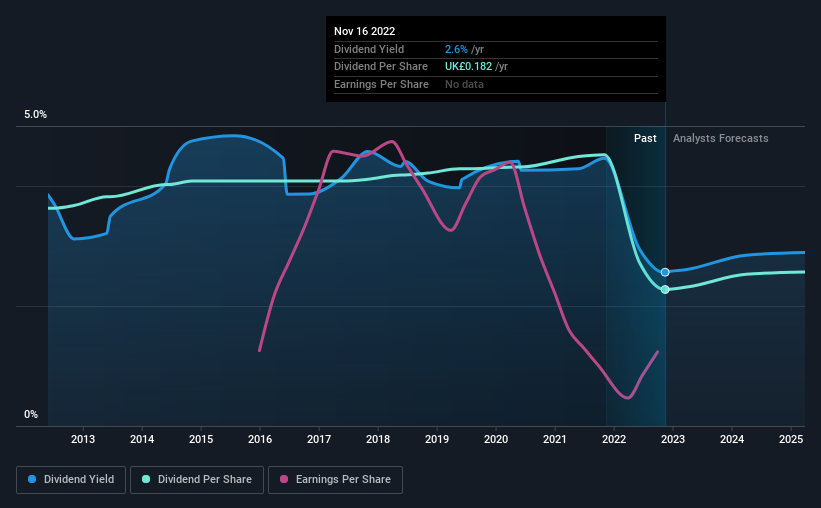- United Kingdom
- /
- Food
- /
- LSE:TATE
Tate & Lyle (LON:TATE) Has Announced That Its Dividend Will Be Reduced To £0.054
Tate & Lyle plc (LON:TATE) is reducing its dividend from last year's comparable payment to £0.054 on the 4th of January. Despite the cut, the dividend yield of 2.6% will still be comparable to other companies in the industry.
Check out the opportunities and risks within the GB Food industry.
Tate & Lyle Doesn't Earn Enough To Cover Its Payments
While it is always good to see a solid dividend yield, we should also consider whether the payment is feasible. Before this announcement, Tate & Lyle was paying out 97% of what it was earning, and not generating any free cash flows either. Paying out such a large dividend compared to earnings while also not generating free cash flows is a major warning sign for the sustainability of the dividend as these levels are certainly a bit high.
EPS is forecast to rise very quickly over the next 12 months. If the dividend continues along recent trends, we estimate the payout ratio could reach 203%, which is unsustainable.

Dividend Volatility
The company's dividend history has been marked by instability, with at least one cut in the last 10 years. The dividend has gone from an annual total of £0.291 in 2012 to the most recent total annual payment of £0.182. The dividend has shrunk at around 4.6% a year during that period. Generally, we don't like to see a dividend that has been declining over time as this can degrade shareholders' returns and indicate that the company may be running into problems.
Dividend Growth Potential Is Shaky
Given that the dividend has been cut in the past, we need to check if earnings are growing and if that might lead to stronger dividends in the future. Over the past five years, it looks as though Tate & Lyle's EPS has declined at around 23% a year. Dividend payments are likely to come under some pressure unless EPS can pull out of the nosedive it is in. On the bright side, earnings are predicted to gain some ground over the next year, but until this turns into a pattern we wouldn't be feeling too comfortable.
We're Not Big Fans Of Tate & Lyle's Dividend
In summary, it's not great to see that the dividend is being cut, but it is probably understandable given that the current payment level was quite high. The company's earnings aren't high enough to be making such big distributions, and it isn't backed up by strong growth or consistency either. Considering all of these factors, we wouldn't rely on this dividend if we wanted to live on the income.
Market movements attest to how highly valued a consistent dividend policy is compared to one which is more unpredictable. At the same time, there are other factors our readers should be conscious of before pouring capital into a stock. Case in point: We've spotted 2 warning signs for Tate & Lyle (of which 1 makes us a bit uncomfortable!) you should know about. If you are a dividend investor, you might also want to look at our curated list of high yield dividend stocks.
Valuation is complex, but we're here to simplify it.
Discover if Tate & Lyle might be undervalued or overvalued with our detailed analysis, featuring fair value estimates, potential risks, dividends, insider trades, and its financial condition.
Access Free AnalysisHave feedback on this article? Concerned about the content? Get in touch with us directly. Alternatively, email editorial-team (at) simplywallst.com.
This article by Simply Wall St is general in nature. We provide commentary based on historical data and analyst forecasts only using an unbiased methodology and our articles are not intended to be financial advice. It does not constitute a recommendation to buy or sell any stock, and does not take account of your objectives, or your financial situation. We aim to bring you long-term focused analysis driven by fundamental data. Note that our analysis may not factor in the latest price-sensitive company announcements or qualitative material. Simply Wall St has no position in any stocks mentioned.
About LSE:TATE
Tate & Lyle
Engages in the provision of ingredients and solutions to the food, beverages, and other industries in North America, Asia, Middle East, Africa, Latin America, and Europe.
Moderate risk with reasonable growth potential.
Similar Companies
Market Insights
Community Narratives




